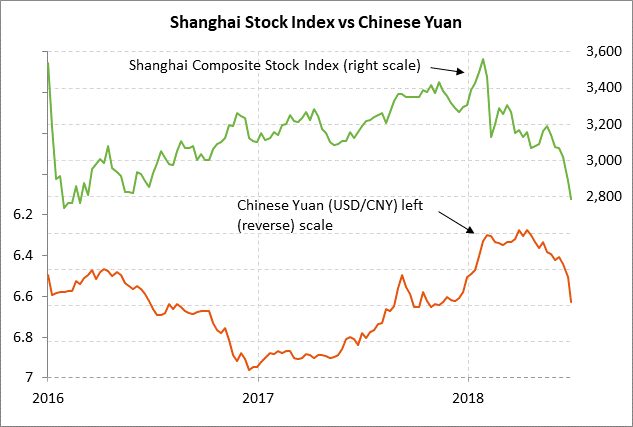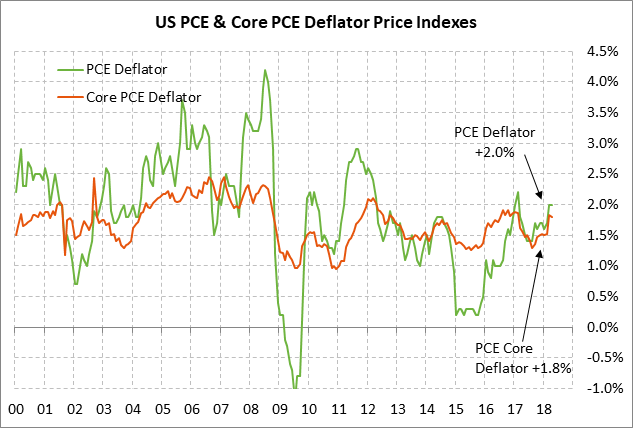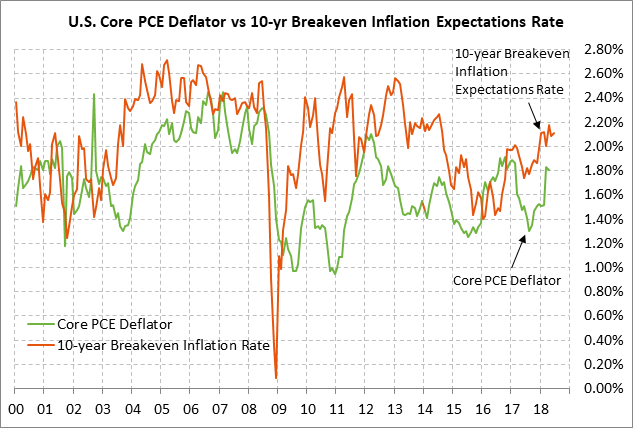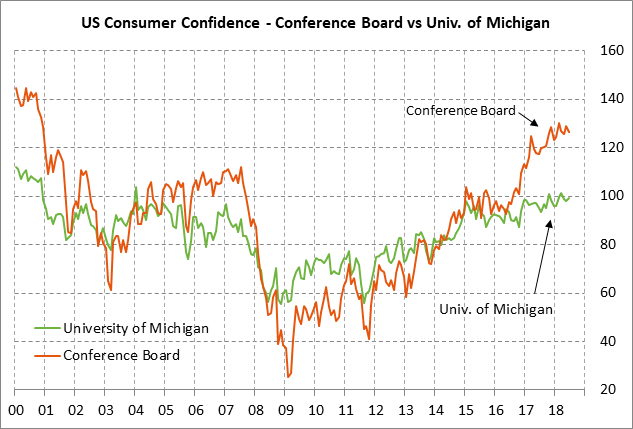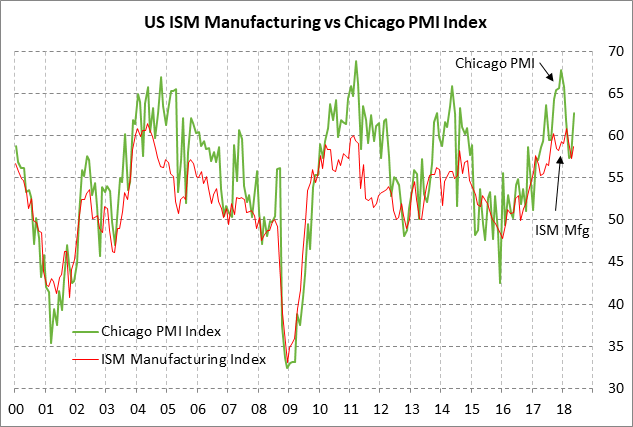- US/China tariff deadline is now only a week away
- U.S. PCE deflator expected to rise to 6-year high and keep Fed on its tightening track
- U.S. personal income and spending expected to remain strong in May
- U.S. consumer sentiment index expected to remain strong
US/China tariff deadline is now only a week away — There are only 7 days left until next Friday (July 6), when the reciprocal 25% tariffs on $34 billion worth of U.S. and Chinese products go into effect. There seems to be little hope for those tariffs to be averted considering that the U.S. and China are miles apart on their trade positions and there seem to be no serious negotiations at this point. The most that the markets can hope for is perhaps a postponement of the tariff implementation date if the two sides decide to engage in serious negotiations in an attempt to reach a comprehensive trade deal.
Separately, the U.S. will hold a hearing on July 24 on the Trump administration’s plan to levy tariffs on another $16 billion of Chinese goods, bringing the total up to $50 billion. China’s list of the $16 billion worth of U.S. products due for a retaliatory tariff include U.S. energy products such as oil and coal.
Also on the trade front, the markets are nervous that Mr. Trump could be getting close to officially announcing the 20% tariff on European auto imports. Mr. Trump on Tuesday said that “we are finishing our study on tariffs on cars from the EU” even though Mr. Trump just announced that specific idea last Friday. The EU will undoubtedly launch another round of retaliatory tariffs against U.S. exports to Europe if the Trump administration goes through with its tariffs on EU autos.
U.S. PCE deflator expected to rise to 6-year high and keep Fed on its tightening track — The market consensus is for today’s May PCE deflator to rise to +2.2% y/y from April’s +2.0%, which would match the 6-year high originally posted in Feb 2017. Meanwhile, today’s May core PCE deflator is expected to edge higher to +1.9% y/y from April’s +1.8%, thus matching the 6-year high of +1.9% posted in late 2016 and early 2017. The PCE deflator is the Fed’s preferred inflation measure.
Today’s expected PCE deflator reports of +2.2% headline and +1.9% core would be very close to the Fed’s inflation target of +2%. The markets will not panic about today’s expected rise in the PCE deflators to a 6-year high because the Fed has made it clear that it will allow inflation to temporarily rise above its 2% inflation target since its target is symmetrical and is not a ceiling. If the Fed had not made that stance explicit, then Treasury yields might rise sharply if the markets thought the Fed was going to panic and start raising interest rates more sharply.
However, the rise in the PCE deflator to the Fed’s inflation target does mean that the Fed has no choice but to continue its current course of steadily raising interest rates. The Fed just raised its funds rate target by +25 bp 1.75-2.00% at its last meeting on June 12-13. The market is discounting another +25 bp rate hike at the meeting after next on September 25-26. The market is then discounting a 60% chance for another +25 bp rate hike at the December 12-13 meeting, which would be the Fed’s fourth rate hike of the year.
Fed Chair Powell last week noted that the funds rate is now only about 100 bp below the “neutral rate,” which the Fed believes to be about 2.9%. That supports the market consensus that the Fed will tighten by another 100 bp to the 2.9% area over the next 1-1/2 years. However, the Fed dots are more hawkish and indicate that the Fed believes it will have to tighten by another +150 bp by the end of 2020 in response to what the Fed expects to be an overshoot of its inflation and labor market goals.
U.S. personal income and spending expected to remain strong in May — The market consensus is for both today’s May personal income and spending reports to show a solid increase of +0.4% following April’s report of +0.3% and +0.6%, respectively. Both income and consumption showed strong year-on-year gains of +3.8% y/y and +4.7% y/y in April, illustrating the benefits for consumers from the Jan 1 tax cut.
U.S. consumer sentiment index expected to remain strong — The market consensus for today’s final-June University of Michigan U.S. consumer sentiment index is for a downward revision by -0.3 points to 99.0. That would leave the index up by +1.0 points from May rather than the larger +1.3 point increase to 99.3 seen in early June. The U.S. consumer sentiment index in any case remains in very strong shape at only 2.1 points below April’s 14-year high of 101.4. U.S. consumer confidence is receiving a boost from (1) the strong U.S. economy and labor market, (2) rising consumer income and household wealth, and (3) the Jan 1 tax cuts. Negative factors include (1) the jittery stock market, (2) trade tensions, (3) Washington political uncertainty, and (4) high gasoline prices.
Chicago PMI expected to remain strong — The consensus for today’s June Chicago PMI is for a -2.7 point decline to 60.0, giving back about one-half of May’s +5.1 point surge to 62.7. Even if today’s Chicago PMI report shows the expected decline, it will still be in strong shape at 60.0, illustrating strong business confidence in the Chicago area.
On the national front, the consensus is for Monday’s June ISM manufacturing index to show a -0.5 point decline to 58.2, giving back about a third of May’s +1.4 point increase to 58.7. The ISM index is in strong shape at only 2.1 points below February’s 14-year high of 60.8. Manufacturing confidence remains strong due to the strong U.S. economy and increased capex spending following the Jan 1 tax cuts. The decline in the dollar index in 2017 was also helpful for manufacturing exports, although the dollar in recent months has recovered to a 1-year high. The ISM new orders index was strong in May with a +2.5 point increase to 63.7, indicating that the orders pipeline is full and will support ongoing strength in production and shipments.

